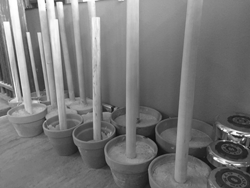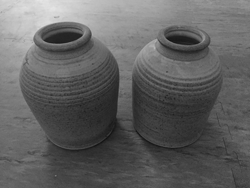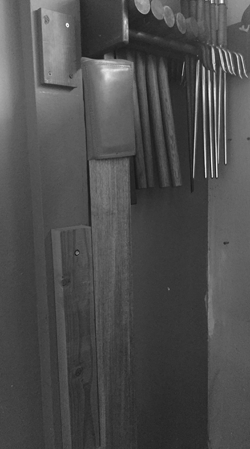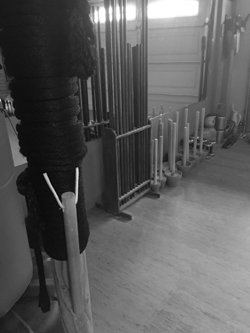“Supplementary exercises, hojo undo, are practiced with the aim of perfecting the kata. The purpose of these exercises is not only to develop strength and power in the body as a whole, but to develop each part of the body individually in order to develop complete body power.”-Miyagi Chojun

Chi Ishi
Chi Ishi (weighted levers) are concrete weights that are attached to a wooden pole. The practitioner strongly grips to the end of the wooden pole (opposite the concrete weight), and moves his or her wrist and arms in motions used in techniques normally used in Kata or against opponents. This weighted training helps strengthens the fingers, hands, arms, and chest.
Ishi sashi
Ishi sashi are hand-held weights in the shape of padlocks, traditionally made of stone.
Tetsu geta
Tetsu geta (iron clogs) are worn like sandals, but requires gripping the clogs with one’s toes. The practitioner then moves around and kicks while wearing these. The extra weight required to move the foot strengthens the leg for kicks.

Nigiri game
Nigiri game (gripping jars) are ceramic jars filled with sand to different weights. The jars are gripped around a lipped rim. Then, while holding the jars, the practitioner moves in varying stances, in order to strengthen the arms, shoulders, back, and legs.
Makiage kigu
The makiage kigu (wrist roller) is a weight hanging by a rope from a wooden handle. The practitioner grasps the handle with the weight hanging in the middle, and twists the handle to wrap the rope around the handle. The handle is raised and lowered throughout the twisting to strengthen the wrists.
Tan
A “Tan” is similar to a modern barbell, made with a wood post and concrete weights on both ends.

Tachi-Makiwara
The “standing” makiwara. This is possibly the most traditional makiwara and employs a flexible board with one end firmly embedded in the ground or solidly fastened to the floor or wall. The Makiwara is used to practice various striking techniques while providing immediate feedback to the practitioner. While a common misconception is that the purpose of the makiwara is to condition the knuckles, this is far from the truth. The true purpose of the Makiwara is to provide progressive resistance to develop power in striking techniques.

Age-Makiwara
This type of Makiwara is hung from the ceiling and secured to the floor with a bungi cord. With this makiwara the practitioner executes various blocks, kicks and elbow to condition the forearms and chins.

